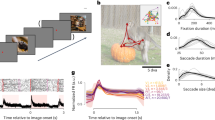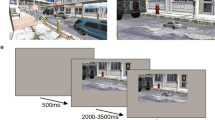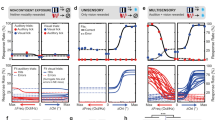Abstract
To investigate how the brain combines knowledge with visual processing to locate eye movement targets, we trained monkeys to search for a target defined by a conjunction of color and shape. On successful trials, neurons in the frontal eye field not only discriminated the target from distractors, but also discriminated distractors that shared a target feature as well as distractors that had been the search target during the previous session. Likewise, occasional errant saccades tended to direct gaze to distractors that either resembled the current target or had been the previous target. These findings show that the frontal eye field is involved in visual and not just motor selection and that visual selection is influenced by long-term priming. The data support the hypothesis that visual selection can be accomplished by parallel processing of objects based on their elementary features.
This is a preview of subscription content, access via your institution
Access options
Subscribe to this journal
Receive 12 print issues and online access
$209.00 per year
only $17.42 per issue
Buy this article
- Purchase on Springer Link
- Instant access to full article PDF
Prices may be subject to local taxes which are calculated during checkout




Similar content being viewed by others
References
Schall, J. D. & Bichot, N. P. Neural correlates of visual and motor decision processes. Curr. Opin. Neurobiol. 8, 211–217 (1998).
Schall, J. D. in Extrastriate Cortex of Primates, vol. 12, Cerebral Cortex (eds. Rockland, K. S., Kaas, J. H. & Peters, A.) 527– 638 (Plenum, New York, 1997).
Baizer, J. S., Ungerleider, L. G. & Desimone, R. Organization of visual inputs to the inferior temporal and posterior parietal cortex in macaques. J. Neurosci. 11, 168–190 (1991).
Schall, J. D., Morel, A., King, D.J. & Bullier, J. Topography of visual cortical afferents to frontal eye field in macaque: functional convergence and segregation of processing streams. J. Neurosci. 15, 4464–4487 (1995).
Segraves, M. A. & Goldberg, M. E. Functional properties of corticotectal neurons in the monkey's frontal eye field. J. Neurophysiol. 58, 1387–1419 (1987).
Segraves, M. A. Activity of monkey frontal eye field neurons projecting to oculomotor regions of the pons. J. Neurophysiol. 68, 1967– 1985 (1992).
Schall, J. D., Hanes, D. P., Thompson, K. G. & King, D. J. Saccade target selection in frontal eye field of macaque. I. Visual and premovement activation. J. Neurosci. 15, 6905– 6918 (1995).
Mohler, C. W., Goldberg, M. E. & Wurtz, R. H. Visual receptive fields of frontal eye field neurons. Brain Res. 61, 385–389 (1973).
Yarbus, A. L. Eye Movements and Vision (Plenum, New York, 1967).
Maljkovic, V. & Nakayama, K. Priming of pop-out: I. Role of features. Mem. Cognit. 22, 657– 672 (1994).
Bichot, N. P. & Schall, J. D. Saccade target selection in macaque during feature and conjunction visual search. Visual Neurosci. 16, 81–89 (1999 ).
Bichot, N. P., Schall, J. D. & Thompson, K. G. Visual feature selectivity in frontal eye fields induced by experience in mature macaques. Nature 381 , 697–699 (1996).
Treisman, A. M. & Gelade, G. A feature-integration theory of attention. Cognit. Psychol. 12, 97–136 (1980).
Townsend, J. T. Serial vs parallel processing: Sometimes they look like tweedledum and tweedledee but they can (and should) be distinguished. Psychol. Sci. 1, 46–54 (1990).
Nakayama, K. & Silverman, G. H. Serial and parallel processing of visual feature conjunctions. Nature 320, 264–265 (1986).
McLeod, P., Driver, J. & Crisp, J. Visual search for conjunctions of movement and form is parallel. Nature 332, 154– 155 (1988).
Wolfe, J. M., Cave, K. R. & Franzel, S. Guided search: An alternative to the feature integration model for visual search. J. Exp. Psychol. Hum. Percept. Perform. 15, 419–433 ( 1989).
Duncan, J. & Humphreys, G. W. Visual search and stimulus similarity. Psychol. Rev. 96, 433– 458 (1989).
Cave, K. R. & Wolfe, J. M. Modeling the role of parallel processing in visual search. Cognit. Psychol. 22, 225 –271 (1990).
Wolfe, J. M. Guided search 2.0. A revised model of visual search. Psychonomic Bull. Rev. 1, 202–228 ( 1994).
Treisman, A. & Sato, S. Conjunction search revisited. J. Exp. Psychol. Hum. Percept. Perform. 16, 456– 478 (1990).
Williams, L. G. The effects of target specification on objects fixated during visual search. Acta Psychol. (Amst.) 27, 355– 360 (1967).
Findlay, J. M. Saccade target selection during visual search. Vision Res. 37, 617–631 (1997).
Kim, M.-S. & Cave, K. R. Spatial attention in visual search for features and feature conjunctions. Psychol. Sci. 6, 376–380 (1995).
Kowler, E., Anderson, E., Dosher, B. & Blaser, E. The role of attention in the programming of saccades. Vision Res. 35, 1897–1916 (1995).
Sheliga, B. M., Riggio, L. & Rizzolatti, G. Spatial attention and eye movements. Exp. Brain Res. 105, 261–275 (1995).
Deubel, H. & Schneider, W. X. Saccade target selection and object recognition: Evidence for a common attentional mechanism. Vision Res. 36, 1827–1837 (1996).
Kustov, A. A. & Robinson, D. L. Shared neural control of attentional shifts and eye movements. Nature 384, 74 –77 (1996).
Desimone, R. & Duncan, J. Neural mechanisms of selective visual attention. Annu. Rev. Neurosci. 18, 193– 222 (1995).
Shiffrin, R. M. & Schneider, W. Controlled and automatic human information processing: II. Perceptual learning, automatic attending, and a general theory. Psychol. Rev. 84, 127–190 (1977).
Bruce, C. J., Goldberg, M. E., Bushnell, M. C. & Stanton, G. B. Primate frontal eye fields. II. Physiological and anatomical correlates of electrically evoked eye movements. J. Neurophysiol. 54, 714–734 (1985).
Buttner-Ennever, J. A., Cohen, B., Pause, M. & Fries, W. Raphe nucleus of the pons containing omnipause neurons of the oculomotor system in the monkey, and its homologue in man. J. Comp. Neurol. 267, 307–321 (1988).
Thompson, K. G., Hanes, D. P., Bichot, N. P. & Schall, J. D. Perceptual and motor processing stages identified in the activity of macaque frontal eye field neurons during visual search. J. Neurophysiol. 76, 4040–4055 ( 1996).
Thompson, K. G., Bichot, N. P. & Schall, J. D. Dissociation of visual discrimination from saccade programming in macaque frontal eye field. J. Neurophysiol. 77, 1046–1050 (1997).
Cave, K. R. The FeatureGate model of visual selection. Psychol. Res. (in press).
Thompson, K. G. & Bichot, N. P. Frontal eye field: a cortical salience map. Behav. Brain Sci. (in press).
Sayer, R. J., Friedlander, M. J. & Redman, S. J. The time course and amplitude of EPSPs evoked at synapses between pairs of CA3/CA1 neurons in the hippocampal slice. J. Neurosci. 10, 826–836 (1990).
Acknowledgements
We thank Randolph Blake and Kirk Thompson for discussions and comments on the manuscript and Sheldon Hoffman for assistance with the TEMPO software. This work was supported by National Eye Institute grants RO1-EY08890 to J.D.S. and P30-EY08126 and T32-EY07135 to the Vanderbilt Vision Research Center. J.D.S. is a Kennedy Center Investigator.
Author information
Authors and Affiliations
Corresponding author
Rights and permissions
About this article
Cite this article
Bichot, N., Schall, J. Effects of similarity and history on neural mechanisms of visual selection . Nat Neurosci 2, 549–554 (1999). https://doi.org/10.1038/9205
Received:
Accepted:
Issue Date:
DOI: https://doi.org/10.1038/9205
This article is cited by
-
Damage to the right temporoparietal junction, but not lateral prefrontal or insular cortex, amplifies the role of goal-directed attention
Scientific Reports (2019)
-
The role of prefrontal cortex in the control of feature attention in area V4
Nature Communications (2019)
-
Parallel basal ganglia circuits for decision making
Journal of Neural Transmission (2018)
-
Attention modulates spatial priority maps in the human occipital, parietal and frontal cortices
Nature Neuroscience (2013)
-
A review of cell assemblies
Biological Cybernetics (2013)



